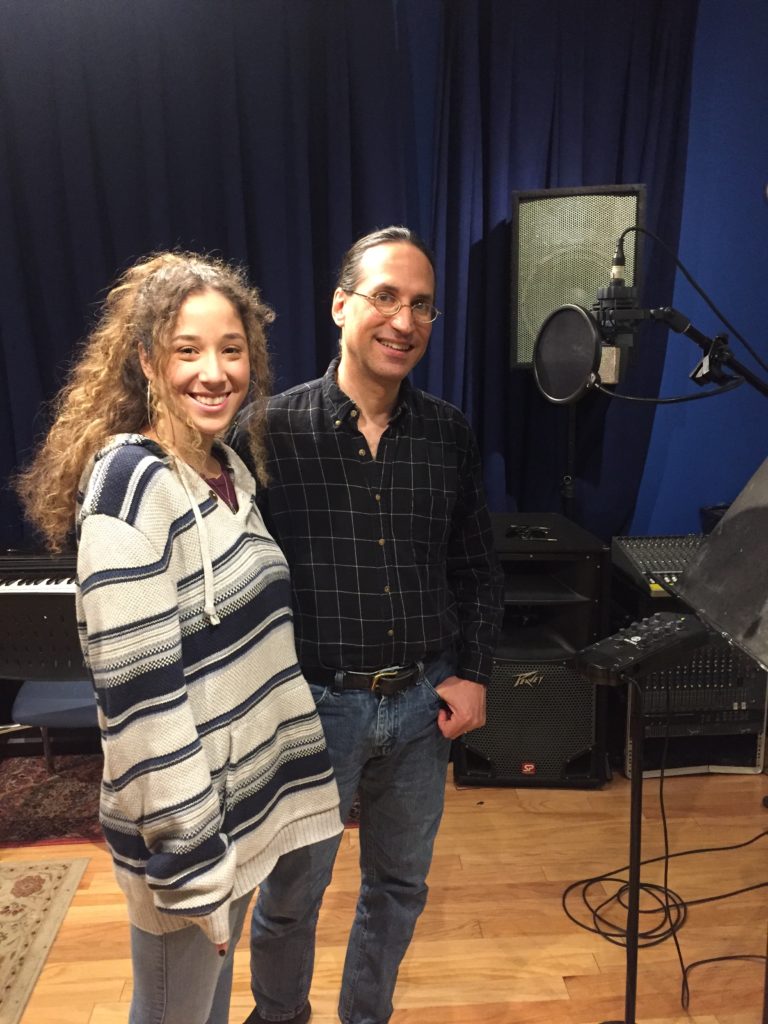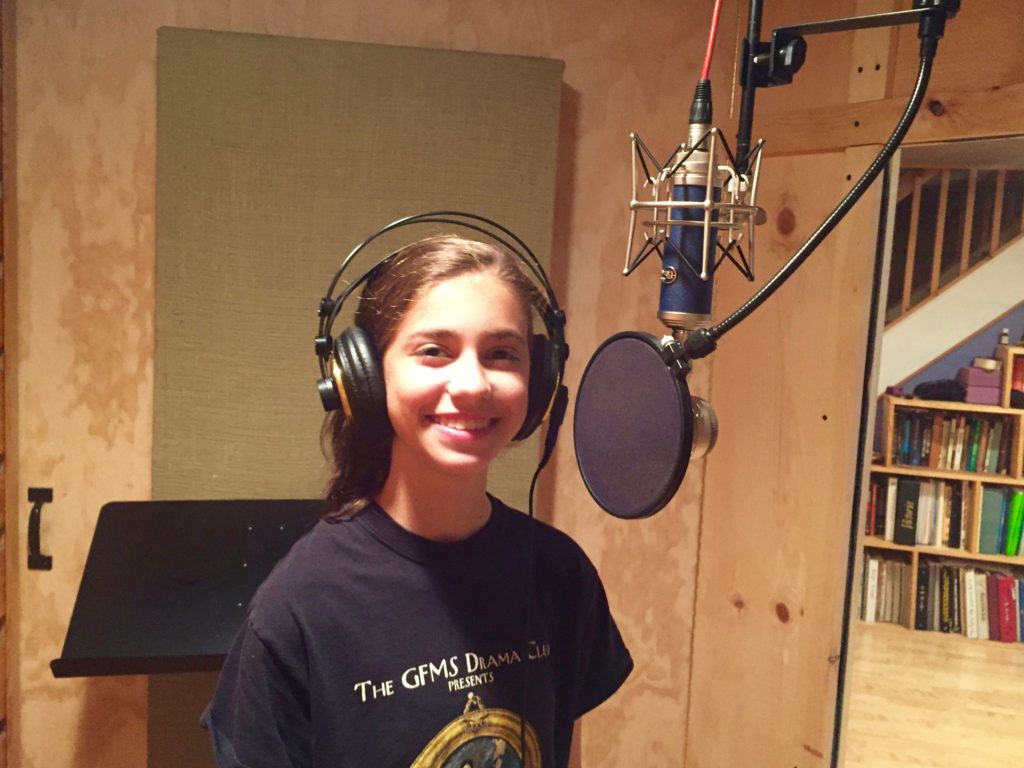It must have been late December or early January this year when I received a text message from Samantha Kenny, one of my former students at Guitar Center Studios (Danbury, CT), where I taught piano, guitar and bass (and got amazing discounts!) from 2012-2018. Samantha stopped taking piano lessons with me after graduating high school and becoming a student at The New School in New York City. It was great to see her again when she came to hear me perform some unusual, experimental music in Brooklyn with Audible Abstraction in September 2017.
Anyway, as I was preparing my syllabi and course content for the Spring 2019 semester at Hostos Community College (Bronx, NY), Samantha reached out to say hello and let me know she was around if I needed help with anything. Perfect timing! For my Production 1 class at Hostos I needed to record a guest soloist for a mixing project at the very beginning of the semester, so I asked Samantha if she wanted to record something in the class for the students to mix. She is not only a pianist, but also a very talented singer/songwriter with a contemporary style. For the recording, she considered playing acoustic guitar and singing, as she does on her very popular Samantha Michelle YouTube channel, but instead, she sang to a prerecorded track that I created for her. We chose the song from three YouTube videos Samantha sent me. I never heard any of them before but my Production class was familiar with all of them! The one I thought was the most manageable for me to do was “Rather Be With You” by Sinead Harnett from her 2016 EP.
I got to work by quickly transcribing all of the parts I heard on the recording by ear, and writing everything down on a couple of sheets of blank manuscript paper. There were so many parts (drums, synthesizers, sound effects, background vocals, etc.) and I knew it would take way too long to recreate it exactly, so I decided to just capture the essence of what I heard while still being somewhat detailed.
When creating the track, to be sure students would have access to the tools I did, I decided to limit myself as much as possible to using the instruments that come with Pro Tools. After creating all of my parts, everything was recorded as audio tracks for the students to mix and the Instrument and MIDI tracks were hidden. For curious students, those tracks could be unhidden and analyzed inside the session. Normally I use a lot of third party instrument software within Pro Tools (or Digital Performer, Logic Pro, etc.) and rarely use the default Pro Tools instrument plug-ins, so this was an educational experience for me too. A couple of times during the semester, I opened up the session in class and showed how I created the sounds for each part.
I used Boom for the drums (kick, snare, rim, clap and hi hat; no toms or cymbals). I needed a shaker loop but couldn’t find one that I liked for this song in Xpand!2 or anywhere else in Pro Tools, so I found one in Spectrasonics Stylus RMX. However, in Xpand!2 I found very good bongo and triangle samples. I layered two sounds together to create the wind effect, and layered three sounds together to create the organ-ish electric piano sound. Toward the end of the song, right before the last chorus, I used iZotope Vinyl on the electric piano track to do the spin down. This incredibly cool plug-in does not come with ProTools but can be downloaded for free from the iZotope website. For the main bass part, I combined two sounds in Structure Free, and for the occasional short synth bass gesture, I created a buzzy sounding patch using Vacuum.
For my version, I had three synth pads. The first was created in Xpand!2 by layering two sounds, the second was created in Xpand!2 by layering three sounds, and the third was created in Structure Free by layering three sounds. Sometimes with all of the patch combining, to help design the final sounds I also modified various parameters (filter cutoff, resonance, etc.) and effects within the instruments.
Since I wasn’t sure if Samantha would be singing any background vocals, I decided to recreate two of the many background vocal parts with synthesizer sounds. I layered two sounds together in Xpand!2 for the repeating crescendo part (“then I realized, then I realized”), and for the main “You…” chorus hook I couldn’t find what I needed in Pro Tools, so I used a “female ooh” sound from Spectrasonics Omnisphere.
The Sinead Harnett track has an extremely vibey feel and I found this challenging to recreate quickly. If I spent more time and messed around with different quantize settings and got into nuanced velocity and duration details, I may have been able to pull it off. Instead of obsessing with any of that, I just opted to record the parts as I wrote them in my transcription and use basic quantize settings to tighten up the performance. Because of this, my track sounds a bit straighter and maybe stiffer in comparison to the original.
On February 5, 2019, Samantha came to Hostos! Oje Paloma (the ultimate lab assistant!) setup a number of microphones and I discussed their differences in frequency response and other features with the class. Samantha sang into all of them for a shootout – Neumann U87, Neumann TLM103 and AKG C414 XLS – except the Bock 195, which was having issues. By vote, the class chose the AKG, so that’s what we used, with a Grace Design m501 preamp and one side of a Universal Audio 2-1176 compressor. Samantha sang a few takes of the lead vocal to my track and she did a fantastic job! She didn’t get to record a lot of background vocal parts, so it was good that I had the synthesizer vocal parts in the track. All of the students made their own mixes and we listened to them in class the following week.
I wanted to make my own mix but I was only able to work on this sporadically at home in between client sessions. To finalize the arrangement, I recorded my super talented 14 year old daughter Maya singing a bunch of the background vocal parts. She doubled the synthesizer vocal parts and also sang some (not all – so many!) of the other parts that we heard on the Sinead Harnett recording. In less than an hour Maya added a number of very substantial harmony parts (Harmony is her middle name!) that made a big difference.
I didn’t limit myself to only Pro Tools plug-ins for my mixing and mastering. I also used my usual palette of effects from Focusrite, Native Instruments and Waves.
“Rather Be With You” (featuring Samantha Kenny)



Love it all, the music, the harmonies and the story!
Samantha has a beautiful voice! This song is very catchy, it has us walking around the house humming it. Great job Maya with the harmonies. 🙂